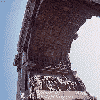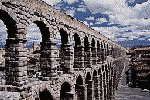

Concrete
- The Romans were probably the greatest architects of the ancient world.
- They borrowed almost all their architectural forms and building techniques from earlier civilizations but had so changed and modified them that by the 1st cent. AD they had created a unique style that would greatly influence the western world.- The style was based on the arch, the vault, and the dome.
- All made possible by a Roman invention, concrete, that did not buckle under
the stresses of the huge structures.
- Civil engineering was another highly developed skill.
- City planners laid out towns supplied with elaborate systems of aqueducts and sewers.
- Cities were connected by vast networks of solidly constructed roads.
- By the middle of the first century AD, the concrete and brick arch had become not only the means for erecting larger buildings but also an expression of sheer architectural beauty.
The Pantheon (Rome's Masterpiece) ![]()
- A temple built in honor of all the gods of the universe in 125 AD at the request of the emperor Hadrian.
- It is the masterpiece of Roman architecture both aesthetically and structurally.
- It is not known exactly how the building was erected but like most Roman buildings its basic ingredients are brick and concrete.
- Hidden within the walls is a framework of brick arches to support the weight of the dome.
- There is no windows except one opening in the center through which light and air enters.
- To provide fresh water for the many public baths and private consumers, aqueducts were constructed to conduct water from the hills down into the city.
- Most of the aqueducts had underground conduits, or pipes,
- A few were bridges with open concrete canals such as the three tiered Pont du Gard in Nimes, France.
- The arch enabled them to span any river or gorge.
- The bridges and aqueducts they built were meant to be functional, but they are also among the most beautiful ever built.
- The most imposing structure built in Rome was the Colosseum.
- This huge amphitheater (double theater) with seating all around
- The arena is also known as the Flavian amphitheater because it was built during the reign of the Emperor Vespasian (69-79 AD).
- The murderous battles of man-and-man and man-and-animal were staged in the Colosseum.
- The oval arena (287 x 180 feet) was surrounded by a 15 foot wall and had deep cells and cellars below.
- It had three tiers of arches, plus a top story with superimposed Doric, ionic, and Corinthian half-columns.
- The 45,000 spectators were protected from rain or fierce sun by huge canvas awnings fixed to masts secured to the topmost rim.
- After nearly two thousand years of pillage by other builders who used it as a quarry for building churches, palaces, and houses, the Colosseum still remains a lasting monument to the indestructible solidity of Roman architecture.
Pleasures of the Arena
Circus Mania
Chariot Races
- By the beginning of the 2nd cent. AD, the Romans seemed to care about little except food and circuses.
- Food was a necessity, but circuses became an addiction of every class in the empire.
- The mania for chariot racing knew no geographical limits.
- Thousands of spectators in every part of the empire attended the races to cheer on the drivers.
- Drivers rode under certain colors.
- Only the wealthiest citizens could afford to keep stables of horses with attendants, trainers, grooms, and chariot makers to produce winners.
- The opportunity to bet on the races added to their popularity.
- Adding to the excitement was the virtual certainty that, on any given day, at least one charioteer strapped to his reins would mess up on a turn, and either be dragged to his death, or cause a spectacular chain reaction of accidents.
- Only the desire to watch gladiators die, equaled the chariot races in attracting spectators.
- Roman emperors devoted many days to these events because of the popularity of the arena.
- Eventually, many citizens were spending as many as 150 of the year in
stadiums or amphi-theaters watching charioteers race, animals being tortured and
butchered, and desperate men kill each other.
- The usual program for a day at the Colosseum would begin with the "venatio," (an event that featured wild animals).
- The animals might be pitted against each other, or sent into the arena to mangle defenseless humans, but the typical display was a simulated hunt during which animals were stalked by "bestiarii"-specialists armed with spears, bows and arrows, and other weapons. (always lots of blood)
- As many as 5000 animals may have died during one day of major festivals such as the inauguration of the Colosseum in 80 AD.
- To keep amphitheaters supplied, a great trade in wild beasts developed.
- Many species virtually disappeared from their home regions of North Africa and the Middle East.
- The animal displays were merely used to wet the audience's appetite for the main attraction-the gladiatorial bouts.
- Roman gladiators were specially trained performers, mostly captured war prisoners, who fought to stay alive a little longer.
- The gladiators specialized in peculiar forms of fighting:
Read The Bible
- 1599 Geneva Bible (GNV)
- 21st Century King James Version (KJ21)
- American Standard Version (ASV)
- Amplified Bible (AMP)
- Amplified Bible, Classic Edition (AMPC)
- Authorized (King James) Version (AKJV)
- BRG Bible (BRG)
- Christian Standard Bible (CSB)
- Common English Bible (CEB)
- Complete Jewish Bible (CJB)
- Contemporary English Version (CEV)
- Darby Translation (DARBY)
- Disciples’ Literal New Testament (DLNT)
- Douay-Rheims 1899 American Edition (DRA)
- Easy-to-Read Version (ERV)
- English Standard Version (ESV)
- English Standard Version Anglicised (ESVUK)
- Evangelical Heritage Version (EHV)
- Expanded Bible (EXB)
- GOD’S WORD Translation (GW)
- Good News Translation (GNT)
- Holman Christian Standard Bible (HCSB)
- International Children’s Bible (ICB)
- International Standard Version (ISV)
- J.B. Phillips New Testament (PHILLIPS)
- Jubilee Bible 2000 (JUB)
- King James Version (KJV)
- Lexham English Bible (LEB)
- Living Bible (TLB)
- Modern English Version (MEV)
- Mounce Reverse Interlinear New Testament (MOUNCE)
- Names of God Bible (NOG)
- New American Bible (Revised Edition) (NABRE)
- New American Standard Bible (NASB)
- New American Standard Bible 1995 (NASB1995)
- New Catholic Bible (NCB)
- New Century Version (NCV)
- New English Translation (NET)
- New International Reader's Version (NIRV)
- New International Version - UK (NIVUK)
- New International Version (NIV)
- New King James Version (NKJV)
- New Life Version (NLV)
- New Living Translation (NLT)
- New Matthew Bible (NMB)
- New Revised Standard Version (NRSV)
- New Revised Standard Version Catholic Edition (NRSVCE)
- New Revised Standard Version, Anglicised (NRSVA)
- New Revised Standard Version, Anglicised Catholic Edition (NRSVACE)
- New Testament for Everyone (NTE)
- Orthodox Jewish Bible (OJB)
- Revised Geneva Translation (RGT)
- Revised Standard Version (RSV)
- Revised Standard Version Catholic Edition (RSVCE)
- The Message (MSG)
- The Voice (VOICE)
- Tree of Life Version (TLV)
- World English Bible (WEB)
- Worldwide English (New Testament) (WE)
- Wycliffe Bible (WYC)
- Young's Literal Translation (YLT)
Table of Contents
Main Menu
- Ancient Assyrian Social Structure
- Ancient Babylonia
- Ancient Canaan During the Time of Joshua
- Ancient History Timeline
- Ancient Oil Lamps
- Antonia Fortress
- Archaeology of Ancient Assyria
- Assyria and Bible Prophecy
- Augustus Caesar
- Background Bible Study
- Bible
- Biblical Geography
- Fallen Empires - Archaeological Discoveries and the Bible
- First Century Jerusalem
- Glossary of Latin Words
- Herod Agrippa I
- Herod Antipas
- Herod the Great
- Herod's Temple
- High Priest's in New Testament Times
- Jewish Literature in New Testament Times
- Library collection
- Map of David's Kingdom
- Map of the Divided Kingdom - Israel and Judah
- Map of the Ministry of Jesus
- Matthew Henry Bible Commentary
- Messianic Prophecy
- Nero Caesar Emperor
- Online Bible Maps
- Paul's First Missionary Journey
- Paul's Second Missionary Journey
- Paul's Third Missionary Journey
- Pontius Pilate
- Questions About the Ancient World
- Tabernacle of Ancient Israel
- Tax Collectors in New Testament Times
- The Babylonian Captivity
- The Black Obelisk of Shalmaneser
- The Books of the New Testament
- The Court of the Gentiles
- The Court of the Women in the Temple
- The Destruction of Israel
- The Fall of Judah with Map
- The History Of Rome
- The Incredible Bible
- The Jewish Calendar in Ancient Hebrew History
- The Life of Jesus in Chronological Order
- The Life of Jesus in Harmony
- The Names of God
- The New Testament
- The Old Testament
- The Passion of the Christ
- The Pharisees
- The Sacred Year of Israel in New Testament Times
- The Samaritans
- The Scribes
Ancient Questions
- Why Do the Huldah Gates Appear Different in Ancient Replicas and Modern Photos?
- What Is the Origin of the Japanese and Chinese Peoples? A Biblical Perspective
- How did the ancient Greeks and Romans practice medicine and treat illnesses?
- What were the major contributions of ancient Babylon to mathematics and astronomy?
- How did the ancient Persians create and administer their vast empire?
- What were the cultural and artistic achievements of ancient India, particularly during the Gupta Empire?
- How did ancient civilizations like the Incas and Aztecs build their remarkable cities and structures?
- What were the major trade routes and trading practices of the ancient world?
- What was the role of slavery in ancient societies like Rome and Greece?
- How did the ancient Mayans develop their sophisticated calendar system?
Bible Study Questions
- Why Do Christians Celebrate Christmas?
- How Many Chapters Are There in the Bible?
- The Five Key Visions in the New Testament
- The 400-Year Prophecy: Unpacking Genesis 15 and the Journey of a People
- The Authorized (King James) Version (AKJV): Historical Significance, Translation Methodology, and Lasting Impact
- Exploring the English Standard Version (ESV): Its Aspects, Comparisons, Impact on Biblical Studies, and Church Use
- A Detailed Historical Analysis of Language Updates in the KJ21: Comparison with Other Versions
- A Detailed Historical Analysis of the American Standard Version (ASV): Comparison to the King James Version, Influence on Later Translations, and Evaluation of Strengths and Weaknesses
- A Detailed Historical Analysis of Amplifications in the Amplified Bible (AMP) and Its Comparison to Other Bible Translations
- Detailed Historical Analysis of the Amplified Bible Classic Edition (AMPC): Examples of Amplifications and Comparative Analysis with Other Bible Translations
About
Welcome to Free Bible: Unearthing the Past, Illuminating the Present! Step into a world where ancient history and biblical narratives intertwine, inviting you to explore the rich tapestry of human civilization.
Discover the captivating stories of forgotten empires, delve into the customs and cultures of our ancestors, and witness the remarkable findings unearthed by dedicated archaeologists.
Immerse yourself in a treasure trove of knowledge, where the past comes alive and illuminates our understanding of the present.
Join us on this extraordinary journey through time, where curiosity is rewarded and ancient mysteries await your exploration.
Recent posts
-

A Historical Journey of Health Insurance: From Ancient Mutual Aid to Modern Coverage
The modern form of health insurance, which is premium based, pooled risk financial coverage during illness is a relatively new development. But the th... -

Get a Crypto License in Poland - Secure, EU-Ready, and Backed by Prifinance Expertise
Expand your crypto business legally in the European Union with a crypto license in Poland under the MiCA framework. Poland has become one of the most ... -

Why Partnering with the Right Mobile App Development Company Can Make or Break Your Project
Why Partnering with the Right Mobile App Development Company Can Make or Break Your Project In today's hyperconnected world, your app is frequently yo... -

Lion Posters & Canvas Wall Art — The Complete Buyer’s & Styling Guide
Collection Spotlight Lion Posters — Wild, Regal Wall Art for Every Interior A single lion portrait can command a room. A pair of lions can change th... -

A Strategic Overview of Shipping Pets to Europe: Navigating EU Regulations from a Global Perspective
The term "shipping pets to Europe" encompasses the complex, regulated process of moving a companion animal from a non-EU country into the European Uni...